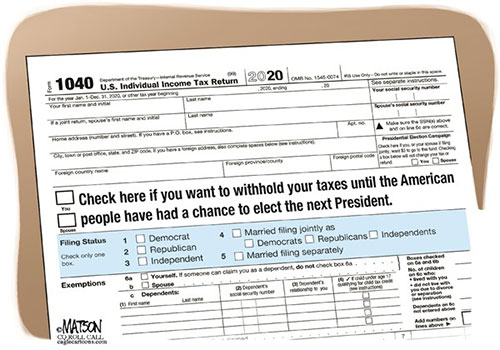
Pondering the Regrettable History of TaxationBy TOM PURCELLSeptember 12, 2016
That's when the Republican presidential candidate promises to lower taxes and the Democrat candidate promises to increase them ---- which makes me ponder the history of taxation in America. The income tax began in Britain way back in 1842. By 1861, it came to America. Americans paid it to help finance the Civil War, but come 1871 ---- six years after the war ---- the tax was finally repealed. Some politicians, however, took a liking to it. They tried for the next 20 years to have it reinstated. But the Supreme Court shot down the income tax as unconstitutional.
New Option To Withhold Taxes Until Next President is Elected
Here's how it worked: Only those who earned more than $3,000 ---- a lot of money in those days (In 2016 dollars = $72,923.33) ---- had to pay. And they only had to pay about 1 percent. (The highest bracket was only 7 percent at that time for those who earned $500,000. [In 2016 dollars = $12,153,888.89]) As you well know, these low tax rates didn't last. By 1918, the top rate ---- the highest rate imposed on the highest earners ---- rose to a whopping 77 percent. Why? So America could finance World War I. And did the rates drop back to pre-war levels when the war ended? Nope. The top rate fell from 77 percent to 25 percent ---- 17 points higher than it was before the war. Then Franklin Delano Big Government came to town. The top rate shot back up to 78 percent by 1936. By the 1940s, another war came along and the top rate shot up to 94 percent. And did taxes go down following the war? Nope. This time the top rate stayed above 90 percent ---- well into the early 1960s. Then John F. Kennedy got elected and reduced the top rate from 90 percent to 70 percent under the Tax Act of 1964. His reductions spurred economic growth. And when politicians realized that lower taxes resulted in more growth and productivity, they eagerly reduced income taxes, right? Wrong. The income tax wasn't reduced again until 1980 when Ronald Reagan took over. In 1981 the top rate was reduced to 50 percent. In 1986, in return for elimination of loopholes, the top rate was reduced to 28 percent. Over the past 20-plus years, there were some slight adjustments to tax rates under President George H.W. Bush, who raised them, President Bill Clinton, who raised them again, President George W. Bush, who lowered them, and President Barack Obama, who increased them again. In any event, our top income tax rate stands at 39 percent and our corporate income tax rate stands at 35 percent, among the highest corporate rates in the world. Donald Trump promises to lower the top income-tax rate to 33 percent and the corporate rate to 15 percent, whereas Hillary Clinton wants to increase the top income tax rate to 45 percent and hasn't issued a plan on the corporate tax rate ---- except to say the rich need to pay more. Regardless of what either will do, hardworking Americans will continue paying massive taxes. In addition to income taxes, we pay taxes on gas, utilities and phone usage. We pay property, sales and transfer taxes. Our states, counties and municipalities tax us. Tally it all up and you'll discover that 50 cents of every dollar we earn goes toward taxes ---- a percentage that isn't likely to change much regardless who the next president is. Which is why I ponder our regrettable history of taxation during presidential campaigns every four years.
©2016 Tom Purcell Tom Purcell, author of "Misadventures of a 1970's Childhood" and "Wicked Is the Whiskey," a Sean McClanahan mystery novel, both available at Amazon.com, is a Pittsburgh Tribune-Review humor columnist and is nationally syndicated exclusively by Cagle Cartoons Inc. E-mail Tom at Tom@TomPurcell.com
Representations of fact and opinions in comments posted below are solely those of the individual posters and do not represent the opinions of Sitnews.
Publish A Letter in SitNews Read Letters/Opinions
|
||
